
Switzerland - Aare Seeland Mobil
For a full scale picture, please click on the picture shown !
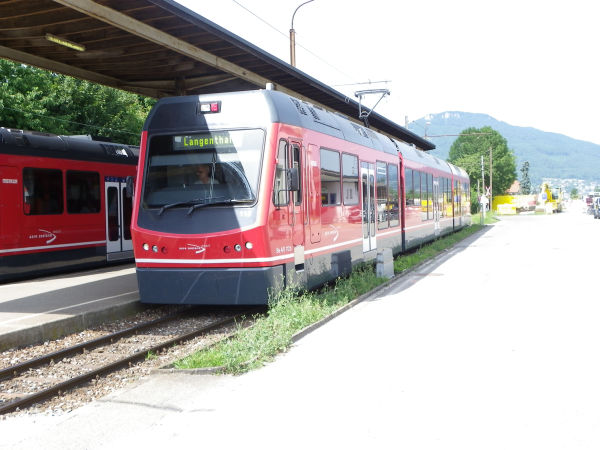
Aare Seeland Mobil AG was founded in 1999 as a fusion product of the railroad companies RVO Regionalverkehr Oberaargau, SNB
Solothurn-Niederbipp-Bahn, BTI Biel-Täuffelen-Ins-Bahn and one bus company Oberaargauischen Automobilkurse, OAK. Aare Seeland Mobil operates trains
on two separate networks. The longer one is the 33,2 km from St.Urban via Langenthal, Niederbipp and Oensingen to Solothurn. This is the
former network of the OJB Oberaargau-Jura-Bahnen and the SNB Solothurn-Niederbipp Bahn. This is metre gauge and electrified with 1200 V DC.
Then there is the 21,19 km long line from Biel via Täuffelen and Siselen to Ins, which is the former BTI Biel-Täuffelen-Ins-Bahn line. That
one is electrified with 1300 V DC.
These new tram-like trains are built by Stadler. It is Stadler's type Star (Schmalspur-Triebzug für attraktiven Regionalverkehr). The
type was specifically developed for the former Solothurn-Niederbipp-Bahn. They were built 2008-2011. Top speed is 80 km/h. They operate
with 1200 V DC. They are fairly similar to the new Be 4/8 trains of Trogenerbahn of Zürich.
Picture from Niederbipp 10.7.2010 by Ilkka Siissalo.
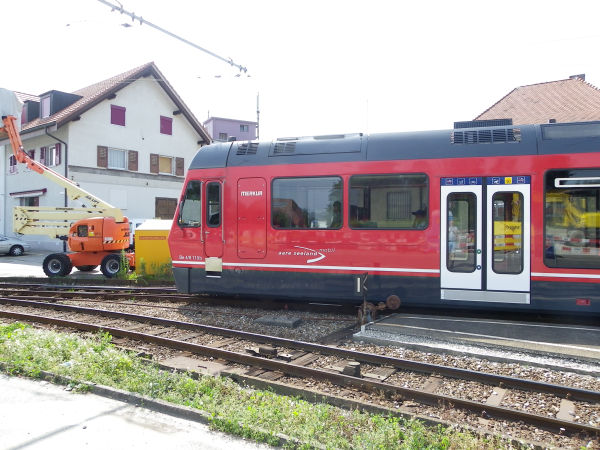
All the new Star tram-trains have their own names. This one, no.110 is called Merkur.
Picture from Niederbipp 10.7.2010 by Ilkka Siissalo.
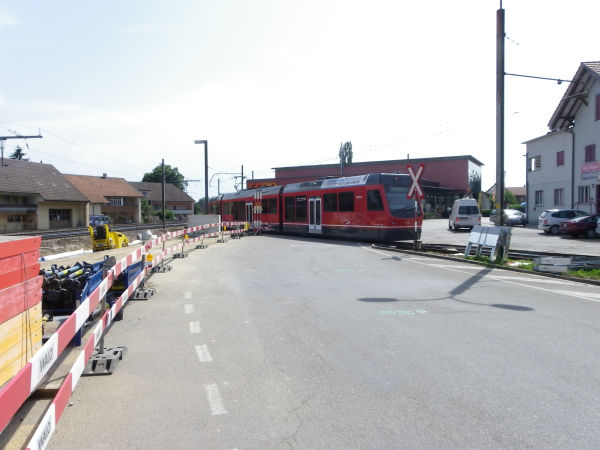
For much of their route these tram-trains run on tracks built in the middle of normal roads.
Picture from Niederbipp 10.7.2010 by Ilkka Siissalo.
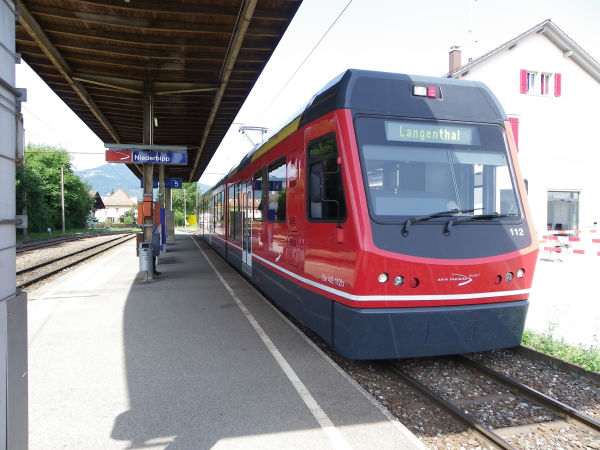
There are six of these tram-trains.
Picture from Niederbipp 10.7.2010 by Ilkka Siissalo.
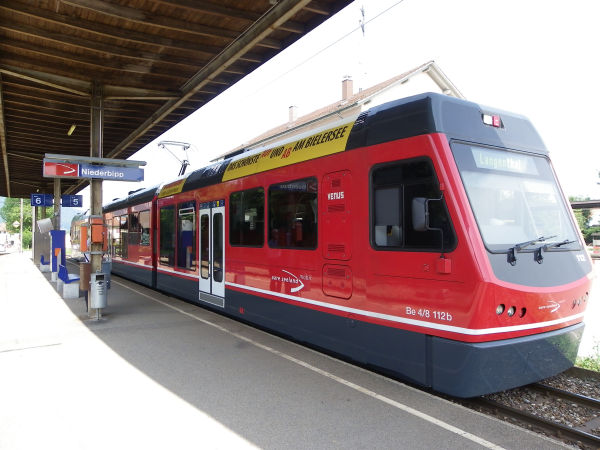
It's a nice looking train with a lot of space. This model served as a starting point for the design of new trains also for the BDWM.
See the category Switzerland > Aargau Verkehr AG.
Picture from Niederbipp 10.7.2010 by Ilkka Siissalo.
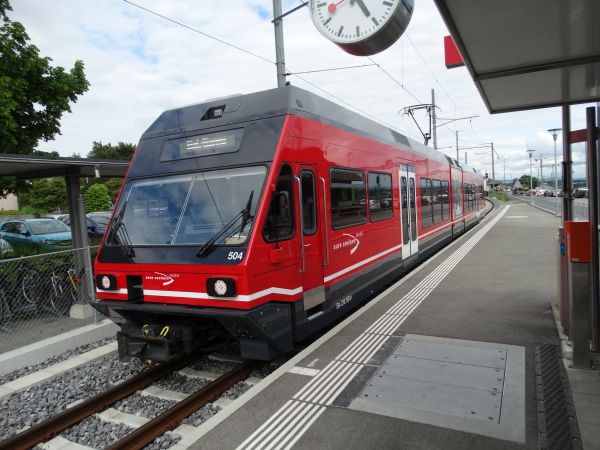
This is the Aare Seeland GTW 2/6 train no. Be 2/6 504. It's already about 20 years old but it has recently been thoroughly modernised.
To see one of the same trains how they used to look like some 20+ years ago, scroll down on this page.
Picture from Ins 12.5.2023 by Ilkka Siissalo.
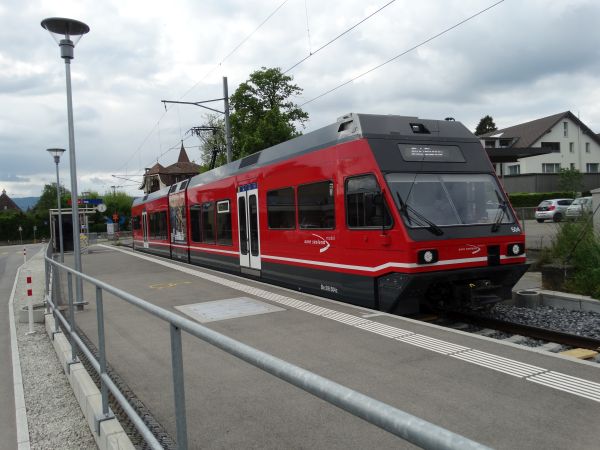
The same GTW 2/6 train no. Be 2/6 504 seen now from the other direction. These early GTW models were rather ugly.
Picture from Ins 12.5.2023 by Ilkka Siissalo.
The former SNB Solothurn-Niederbipp Bahn
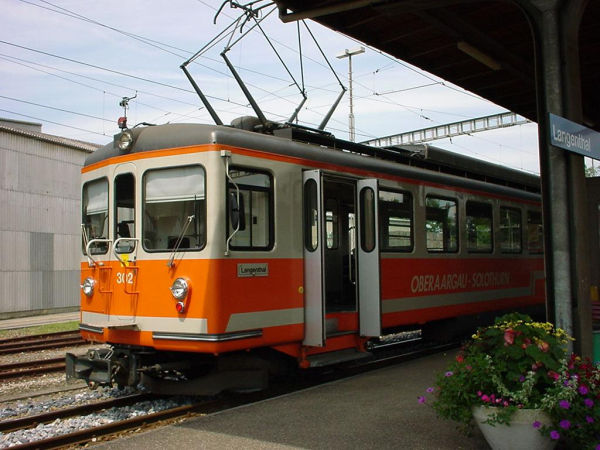
The Solothurn-Niederbipp-Bahn SNB was one of the smallest of the over 30 private railroads in Switzerland. The company operates
a short track in the Kantons of Solothurn and Aargau, feeding traffic from small villages to the main railroad lines in
Langenthal and Niederbipp. Track is narrow gauge, 100 cm, and has been opened in 1918. The company had four electric motor units
of the type Be 4/4, built 1966-78, each weighing 35 tons, being 18,10 m long and having a maximum speed of 65 km/h. Number 302 shown
here went through a modernisation in 1998-99. During the modernisation the train's red and white colouring scheme was changed to
this orange-white of RVO.
Picture taken at Langenthal station 14.10.2001 by Ilkka Siissalo.
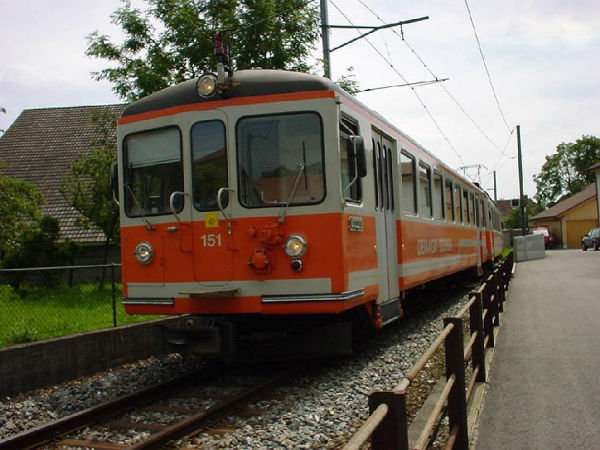
The Solothurn-Niederbipp-Bahn SNB's four electric motor units used to operate usually each with one steering wagon, here no. 151 attached
to EMU Be 4/4 no. 302. Note the Swiss habit for end of train signal: just one white light is on.
Picture taken at Niederbipp village 14.10.2001 by Ilkka Siissalo.
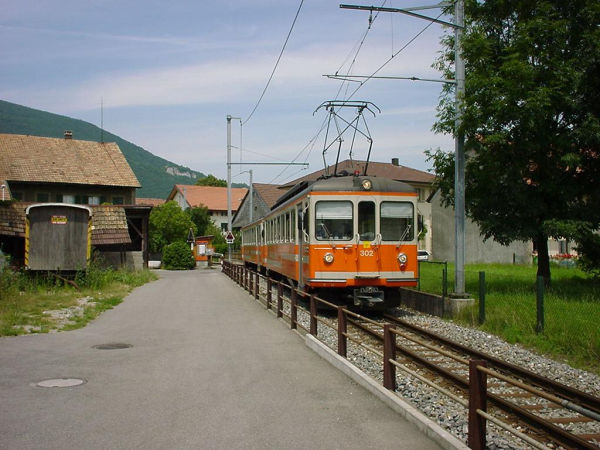
The Solothurn-Niederbipp-Bahn SNB's Be 4/4 no. 302 stopping to take a passenger at Niederbipp village in July 1999. Note the missing
of any kind of a station, just a ticket automate is placed in a small wooden shelter by the railroad crossing.
Photo from Niederbipp 14.10.2001 by Ilkka Siissalo.
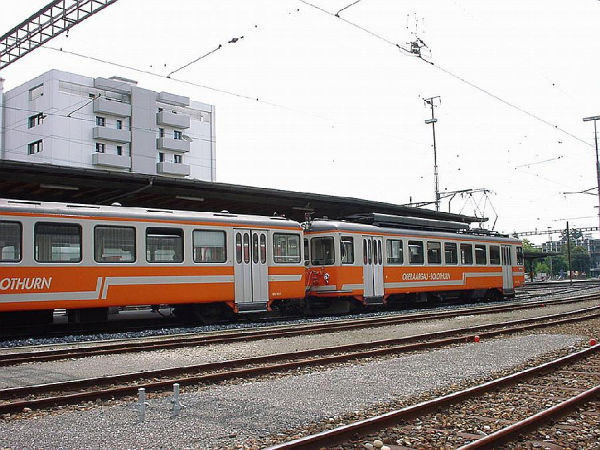
The small narrow gauge train has arrived from the village of Niederbipp into Langenthal, where there is a station with connections to the
state railways SBB's normal gauge services.
Picture from Langenthal 15.10.2001 by Ilkka Siissalo.
The former RVO, Regionalbahn Oberaargau
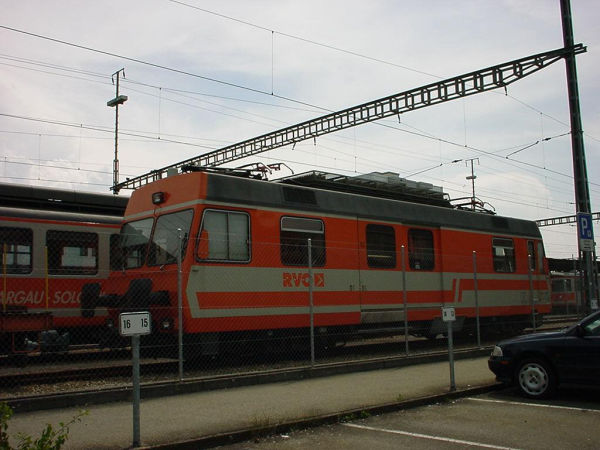
This diesel / electric De 4/4 no. 121 of the RVO was another unique example - only one of its kind. It and the oldtimer Ge 4/4 from 1917
were the only engines designated as locomotives at the narrow gauge RVO/SNB "network" of about 30 km track. It was built in 1987, deliberately
fitted with huge oversize buffers and equipped for all kinds of railroad track and aerial cable maintenance work. It was 14,4 meters long,
weighed 49 tons and had a maximum speed of 65 km/h. It could operate both with electricity or on diesel power.
Picture from Langenthal 15.10.2001 by Ilkka Siissalo.
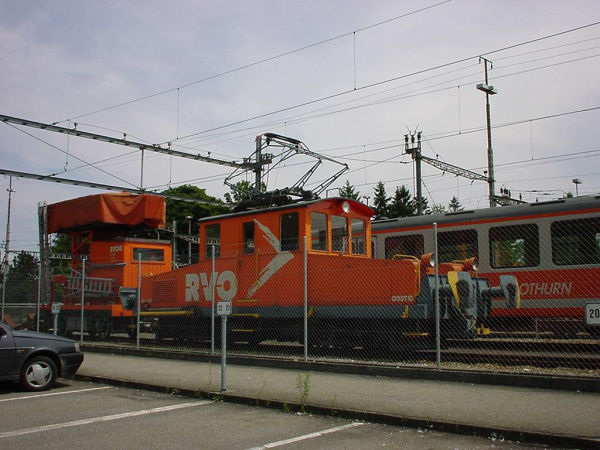
This oldtimer, Ge 4/4 no. 56 from 1917 was one of the famous "Bernina-Krokodil" engines designed for the narrow gauge Rhätische Bahn network
in the beginning of the nineteen hundreds. It used to belong to the LMB company and used to drag passenger wagons in Aargau in the twenties.
In 1972 it was unfortunately spoiled by adding oversized modern buffers and a modern painting which doesn't fit the oldtimers' elegance
and it got the number of 126 of RVO. Since then it has been in occasional use for spreading gravel. It weighs 20 tons and achieves a modest
maximum velocity of 35 km/h.
Picture from Langenthal 15.10.2001 by Ilkka Siissalo.
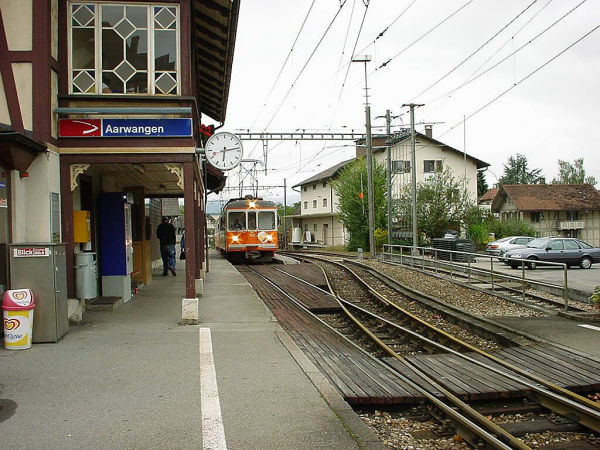
RVO's Be 4/4 motor wagon with one driver's cab coach is approaching the small station of Aarwangen. Note that the station building had already
received the logo of the new company Aare Seeland Mobil, although the old train was still carrying the texts of RVO.
Picture from Aarwangen 1.9.2002 by Ilkka Siissalo.
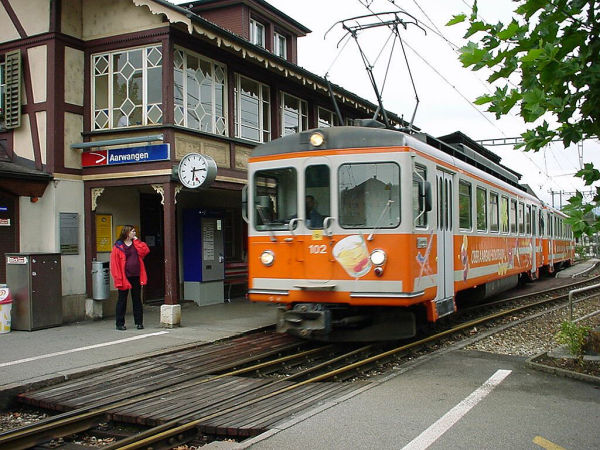
Another view of the RVO's Be 4/4 motor wagon no.102.
Picture from Aarwangen 1.9.2002 by Ilkka Siissalo.
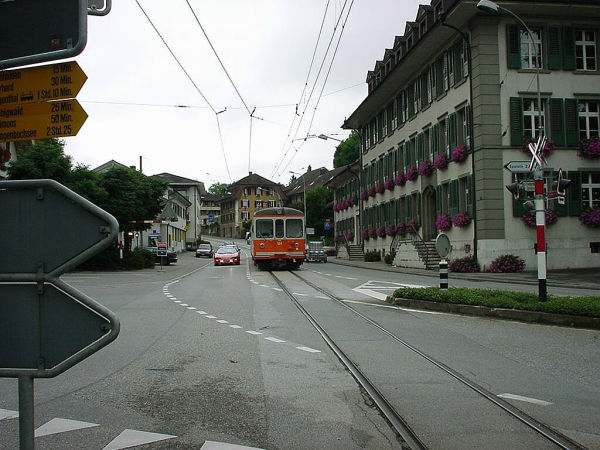
In many places the narrow gauge train line runs right in the middle of a street in tightly built villages.
Picture from Aarwangen 1.9.2002 by Ilkka Siissalo.
The former BTI Biel-Täuffelen-Ins-Bahn
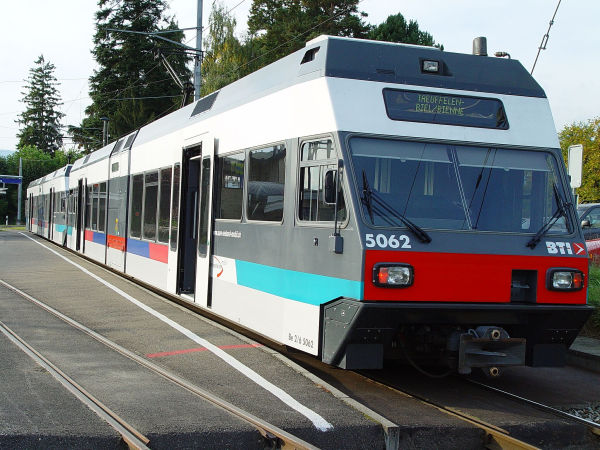
The former BTI Biel-Täuffelen-Ins-Bahn line from Biel to Ins is separate from the rest of the Aare Seeland Mobil's train lines and it is also technically
separate because of its exotic voltage of 1700 V DC. It is a metre gauge line. For years and years now, most of the traffic has been run with these boxlike
Stadler GTW 2/6 trains. These are early precursors of today's GTW 2/6 models. Here we see the train still in the paintings of the former BTI, but it has
already received Aare Seeland Mobil stickers on its sides near the doors. Later these same trains were painted dark red like the rest of Aare Seeland's
trains now are.
Picture from Ins 5.10.2002 by Ilkka Siissalo.

The same train as above, but seen more from its side.
Picture from Ins 5.10.2002 by Ilkka Siissalo.

The older trains of the former BTI line were very similar to the former SNB of RVO type Be 4/4 motor wagons, but the voltage used is different and the couplers
used between coaches were totally different type automatic couplers at the BTI line. This motor wagon is still in the very old orange colours, but has already
the new Aare Seeland Mobil logo on its sides.
Picture from Ins 5.10.2002 by Ilkka Siissalo.

